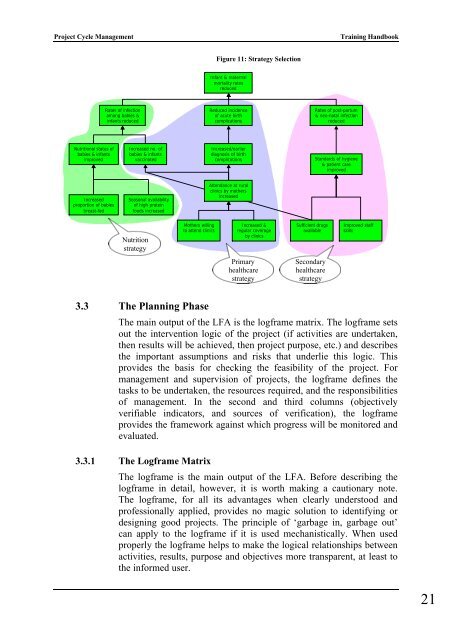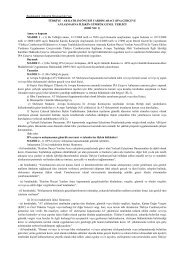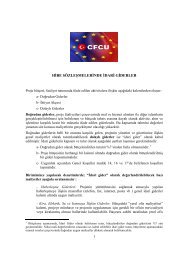Project Cycle Management Training Handbook - CFCU
Project Cycle Management Training Handbook - CFCU
Project Cycle Management Training Handbook - CFCU
Create successful ePaper yourself
Turn your PDF publications into a flip-book with our unique Google optimized e-Paper software.
<strong>Project</strong> <strong>Cycle</strong> <strong>Management</strong> <strong>Training</strong> <strong>Handbook</strong><br />
Nutritional status of<br />
babies & infants<br />
improved<br />
Increased<br />
proportion of babies<br />
breast-fed<br />
Rates of infection<br />
among babies &<br />
infants reduced<br />
Increased no. of<br />
babies & infants<br />
vaccinated<br />
Seasonal availability<br />
of high protein<br />
foods increased<br />
Nutrition<br />
strategy<br />
Mothers willing<br />
to attend clinics<br />
3.3 The Planning Phase<br />
Figure 11: Strategy Selection<br />
Infant & maternal<br />
mortality rates<br />
reduced<br />
Reduced incidence<br />
of acute birth<br />
complications<br />
Increased/earlier<br />
diagnosis of birth<br />
complications<br />
Attendance at rural<br />
clinics by mothers<br />
increased<br />
Increased &<br />
regular coverage<br />
by clinics<br />
Primary<br />
healthcare<br />
strategy<br />
Sufficient drugs<br />
available<br />
Secondary<br />
healthcare<br />
strategy<br />
Rates of post-partum<br />
& neo-natal infection<br />
reduced<br />
Standards of hygiene<br />
& patient care<br />
improved<br />
Improved staff<br />
skills<br />
The main output of the LFA is the logframe matrix. The logframe sets<br />
out the intervention logic of the project (if activities are undertaken,<br />
then results will be achieved, then project purpose, etc.) and describes<br />
the important assumptions and risks that underlie this logic. This<br />
provides the basis for checking the feasibility of the project. For<br />
management and supervision of projects, the logframe defines the<br />
tasks to be undertaken, the resources required, and the responsibilities<br />
of management. In the second and third columns (objectively<br />
verifiable indicators, and sources of verification), the logframe<br />
provides the framework against which progress will be monitored and<br />
evaluated.<br />
3.3.1 The Logframe Matrix<br />
The logframe is the main output of the LFA. Before describing the<br />
logframe in detail, however, it is worth making a cautionary note.<br />
The logframe, for all its advantages when clearly understood and<br />
professionally applied, provides no magic solution to identifying or<br />
designing good projects. The principle of ‘garbage in, garbage out’<br />
can apply to the logframe if it is used mechanistically. When used<br />
properly the logframe helps to make the logical relationships between<br />
activities, results, purpose and objectives more transparent, at least to<br />
the informed user.<br />
21





